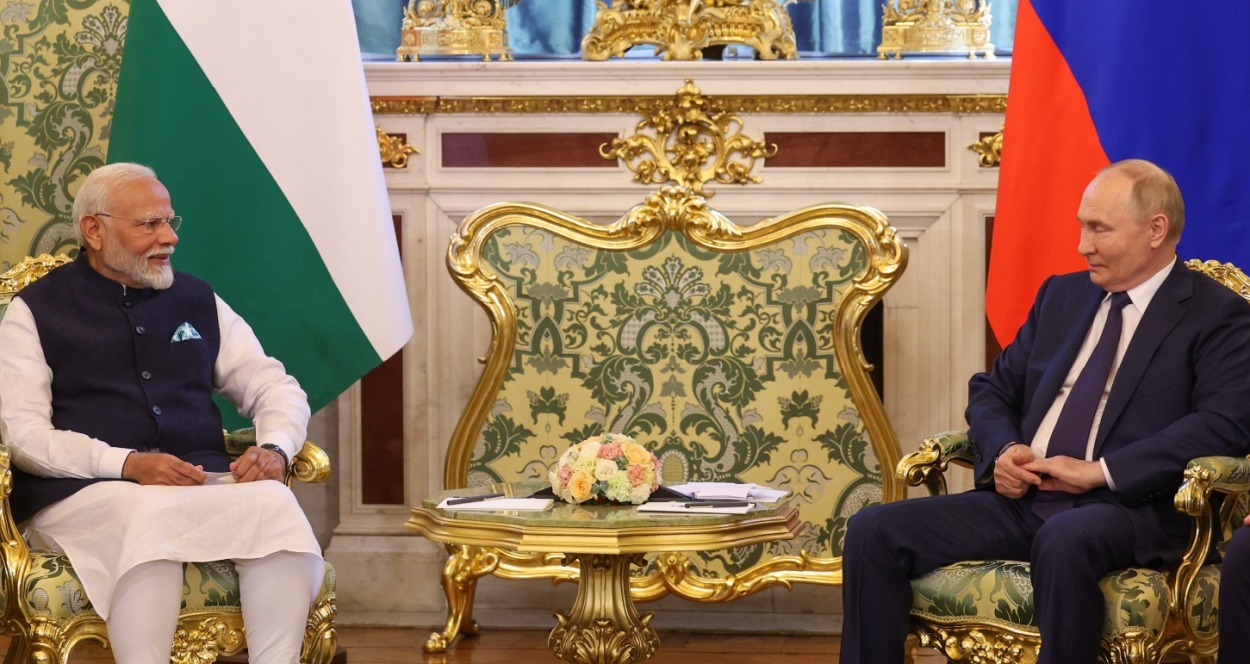In balancing its burgeoning relationship with the US with its long-term ally Russia, New Delhi was poised to seal the deal for military logistics with Moscow after years of delay.
Prime Minister Narendra Modi visited Russia, where he was warmly greeted by President Vladimir Putin. During the visit, the long-awaited Reciprocal Exchange of Logistics Agreement (RELOS) was expected to be signed, paving the way for simplified logistical support for military operations, including military exercises, training, port calls, humanitarian assistance, and disaster relief efforts.
Despite Russia and India having long standing defense ties, India inked a similar agreement with the US way before in 2016. Once signed, the RELOS will be valid for five years and automatically renewed unless either country decides to terminate it.
The biggest winner of RELOS would have been the Indian Navy, which would get access to Russian military facilities in the Arctic. With its economy largely dependent on agriculture, India will be impacted by the climate change around the Arctic, rising sea levels, and the monsoon pattern. The sea level in the Arctic has been declining at a rate of 13 percent per decade.
Also, the melting of the Arctic ice will open new shipping routes and redraw the global sea trade map. India wants to develop the International North-South Corridor with Moscow and link it to the Arctic to build trans-Arctic shipping routes and decrease shipping costs.
Experts see RELOS as beneficial to both countries and that they should encourage each other’s presence in their respective regions. RELOS would aid the Russian Navy operating in the Indian Ocean Region and the Indian Navy in the Arctic.
“This (RELOS) should lead to institutionalized cooperation between the two navies, between the Russian Pacific Fleet headquartered in Vladivostok and India’s Eastern Fleet based in Visakhapatnam, by posting liaison officers (Los) to each other’s headquarters, just as the Indian Navy has posted LOs to INDOPACOM headquartered in Hawaii, and the US-led multinational maritime force, Combined Maritime Forces (CMF) in Bahrain,” Captain Anurag Bisen (retired) a veteran Indian Navy submariner told the EurAsian Times. He has been instrumental in drafting and coordinating the approval process of India’s Arctic Policy, released by the Government in March 2022.
“It should also lead to the Indian Navy and the Russian Navy signing a White Shipping information sharing agreement as the Indian Navy has done with 36 other navies and multilateral constructs. The signing of RELOS will also help the Indian Navy in the protection of the Chennai-Vladivostok Maritime Corridor (CVMC) when it is fully operationalized,” Captain Bisen opined.
India’s only big-ticket defense acquisition from Russia has been S-400 long-range surface-to-air missiles. While three squadrons of the missiles have been delivered, the remaining two squadrons have been delayed following the outbreak of war in Ukraine.
Recently, Russia announced the deal for local manufacturing of “Mango” armor-piercing rounds for the Indian Army’s T-72 and T-90 tanks. The two countries are also expected to sign a long-term Uranium supply pact for a nuclear power plant in Tamil Nadu.
The India-Russia relationship has undergone a tectonic change in the past few years. No longer is Russia the sole supplier of weapon platforms to India.

US Weapons Storm India
Two decades ago, the US defense sales to India were almost zero. Now, the two countries are discussing joint production of major systems. Today, the US accounts for 10 percent of India’s defense imports (by value). India is the world’s largest defense importer, accounting for 10 percent of global arms imports from 2008 to 2023.
A recent report released by the Stockholm International Peace Research Institute (SIPRI) notes that “although Russia remained India’s main arms supplier (accounting for 36 percent of its arms imports), this was the first five-year period since 1960–64 when deliveries from Russia (or the Soviet Union before 1991) made up less than half of India’s arms imports.”
This shows that although Russia is still India’s biggest weapons supplier, weapons sales from the U.S. to India have increased dramatically.
In the next 10 years, New Delhi is expected to spend at least US $200 billion to modernize its armed forces. Even as India’s defense arsenal has a Russian bias, Western countries have been working to steer India away from its ally.
Since 2008, about 62 percent of India’s defense imports (by value) have come from Russia; other top suppliers include France (11 percent), the United States (10 percent), and Israel (7 percent).
Before 2008, the US-India defense trade was restricted to naval helicopters and counter-battery radars in the mid-2000s. In 2007, the US also provided India with an amphibious transport dock ship under the US Excess Defense Articles program—the former USS Trenton, now the INS Jalashwa.
Now, India has contracted for nearly US $20 billion worth of US-origin military equipment since 2008, according to the Defense Department. Most of the deals with the US have been made through the Foreign Military Sales route.
In the last 15 years, India has purchased a C-130J Super Hercules special mission aircraft, a C-17 Globemaster III heavy lifter, and P-8I Poseidon anti-submarine warfare aircraft. In fact, outside the US, India is the largest operator of C-17s and P-8Is. In the rotary wing department, India has purchased attack helicopters CH-47F Chinooks, MH-60R Seahawks, and AH-64E Apaches.
Other purchases include Harpoon anti-ship missiles and M-777 howitzers. The two countries have inked an agreement to jointly produce advanced F-414 jet engines in India. The purchase of 31 MQ-9B Sea Guardian and Sky Guardian unmanned aerial vehicles for more than US $3 billion has been approved.
Other proposed sales include turbofans for indigenously produced Indian combat aircraft, MK 54 lightweight torpedoes, and additional Hellfire anti-tank missiles and Excalibur guided artillery rounds.
The two countries are also discussing jointly producing Stryker Armoured vehicles and Javelin anti-tank missiles. Besides this, the US government is in contention to supply medium-role Fighter Aircraft, for which the government is offering F-21 Fighting Falcon and F-15EX Eagle II fighter jets.
- Ritu Sharma has been a journalist for over a decade, writing on defense, foreign affairs, and nuclear technology.
- The author can be reached at ritu.sharma (at) mail.com
- Follow EurAsian Times on Google News




